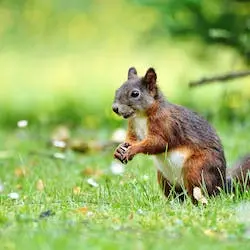
Level 1:
Have you seen squirrels jumping in trees? They are very good at it. They can climb up and down trees and jump from branch to branch. Do you know how they do it? Their bodies are special. They can move in ways other animals cannot. This helps them find food and stay safe. Let’s learn more about squirrels’ amazing bodies.
Level 2:
Squirrels are nature’s own acrobats. Have you ever seen a squirrel leap from branch to branch or dart up a tree trunk? Their athleticism is astonishing. But, have you ever wondered why they’re so flexible?
Squirrels are specially designed for life on the move. Their flexible bodies allow them to perform feats of acrobatics that would put even the most skilled gymnast to shame. But what makes their bodies so special? Let’s dive into the fascinating world of squirrel anatomy.
Full Story:
Squirrels - they’re adorable, industrious, and astonishingly agile. These little critters melt our hearts with their charming antics and their mind-boggling acrobatics. But what makes squirrels such excellent climbers and jumpers? Why are they so flexible?
The Backbone of Flexibility
The key lies in their remarkable spine. Squirrels are blessed with extraordinarily flexible backbones, which give them an impressive range of motion. Unlike many other species, squirrel vertebrae are not held together tightly, allowing for much greater flexibility. This enables them to twist, turn and bend in ways that are almost unimaginable for many other animals.
The Power of Long Limbs
Squirrels also have long, powerful hind legs that allow them to execute dramatic leaps. These limbs, coupled with sharp claws, provide the gripping power they need to navigate the treetops and make mid-air corrections during their remarkable leaps.
Adaptable Ankles
Perhaps the most surprising of these adaptations is found in their ankles. Squirrels have what’s called ‘reversible ankles.’ This means they can rotate their hind feet so that they point backwards, a feature that proves incredibly useful when rapidly descending a tree.
Tails that Act as Balancing Rods
Their bushy tails also play a significant role. They not only help them balance while navigating narrow branches but also act as a parachute during falls, slowing down their descent and allowing them to land a little more softly.
All these physical adaptations give squirrels an edge in their arboreal environment. The athleticism of squirrels is more than just fascinating to observe - it ensures their survival in the wild, helping them escape predators, traverse their environment quickly, and hunt down food efficiently.
So, the next time you are enjoying watching the squirrels in your backyard or local park, take a moment to appreciate the amazing attributes that enable them to be such incredible acrobats.
Questions:
Question: What factors contribute to a squirrel’s flexibility and agility?
Answer: A squirrel’s flexibility and agility are largely due to their unique physical attributes. These include an extraordinarily flexible backbone, long and powerful hind legs, reversible ankles, and a large bushy tail that assists with balance and acts as a parachute during falls.
Question: Why are squirrels considered nature’s acrobats?
Answer: Squirrels are considered nature’s acrobats due to their remarkable ability to jump, climb, and move swiftly through their environment. They can navigate through trees with ease, perform mid-air corrections, and quickly escape from predators due to their flexibility and agility.
Question: How does a squirrel’s flexibility aid in its survival?
Answer: A squirrel’s flexibility aids in its survival by enabling it to avoid predators, move quickly through its environment, hunt for food efficiently, and perform other necessary behaviors. The ability to rapidly descend trees head-first, jump great distances, and maintain balance on narrow branches are all crucial for survival.
Fill in the Blanks:
flexible, athleticism, special, world, anatomy, mainly, backbone, vertebrae, long, powerful, hind, legs, reversible, ankles, tail, balance, parachute, descent, adaptations, environment, survival, predators, navigate, efficiently
Have you ever wondered why squirrels are so ________ and display such impressive ________? It’s mainly due to their ________ body structure specifically designed for an active life. Let’s dive into this fascinating ________ and unravel the secrets of squirrel ________.
The key to their flexibility lies ________ in their ________. Squirrels possess extra-flexible ________ that allow them an impressive range of motion. Their ________, ________ ________ ________, coupled with sharp claws, provide the strength they need to jump long distances and adjust their path mid-air.
But that’s not all, squirrels also have ’________ ________’ - they can rotate their feet backwards to quickly scamper down a tree head-first. And let’s not forget about their prominent bushy ________ - not only does it help maintain ________ while travelling through treetops, but it also acts as a ________ during a fall, slowing their ________.
All these physical ________ give squirrels a survival advantage in their arboreal ________. The agility and dexterity of squirrels help ensure their ________. They can move swiftly to escape ________, ________ through their environment quickly, and hunt down food ________.
Vocabulary:
Flexibility: The quality of bending easily without breaking, the ability to be easily adjusted to respond to altered circumstances.
Athleticism: The physical and mental qualities that are characteristic of athletes, such as strength, fitness, and agility.
Special: Better, greater, or otherwise different from what is usual.
World: A particular aspect of life, an environment or setting.
Anatomy: The branch of science concerned with the bodily structure of humans, animals, and other organisms.
Mainly: More than anything else, primarily.
Backbone: The series of vertebrae extending from the skull to the pelvis; the spine.
Vertebrae: The series of small bones forming the backbone.
Long: Measuring a great distance from end to end.
Powerful: Having great power or strength.
Hind Legs: The back limbs of an animal, contrasted with fore (front) limbs.
Reversible Ankles: Ankles that can rotate to point the foot backwards.
Tail: The hindmost part of an animal.
Balance: An even distribution of weight enabling someone or something to remain upright and steady.
Parachute: A device that slows the motion of an object through the atmosphere by creating drag, often used during descent.
Descent: A movement or journey downwards.
Adaptations: The process of change by which an organism or species becomes better suited to its environment.
Environment: The surroundings or conditions in which a person, animal, or plant lives or operates.
Survival: The state of continuing to live or exist, typically in spite of challenging circumstances.
Predators: Animals that naturally preys on others.
Navigate: To plan, record, and control the course and position of a journey.
Efficiently: In a way that achieves maximum productivity with minimum wasted effort or expense.




